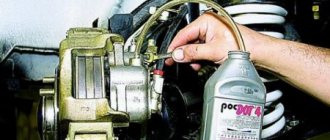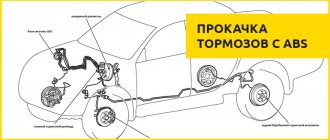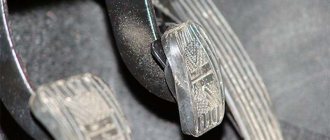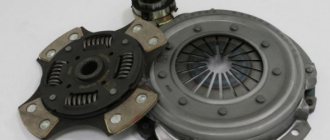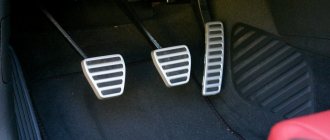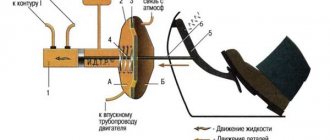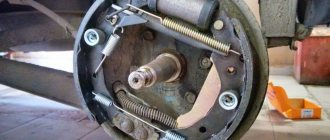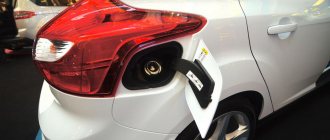How to bleed the brakes on a VAZ 2114 video instruction
Most often, it is necessary to bleed the brakes in different cars, including the VAZ-2114, after the brake fluid has been replaced. Air can also get into the brake system when replacing any unit. If there is air, the system is unable to function normally. A sign of the presence of air in the system is the “pushing” of the pedal when you press it. Moreover, if you press the pedal several times in a row, it returns to its normal position. If you are faced with such a situation, you should find out how to properly bleed the brakes on a VAZ-2114. By following certain rules, you will be able to complete this procedure quickly and without any problems.
Preparatory stage
If you decide to bleed the brakes yourself, it is important to know that when bleeding you must use the same brake fluid as the one in the system. No other liquid can be used
You must first check the tightness of the system. To level up you need one more person. You will also need a hose of a suitable diameter for the bleeder fitting, a glass or plastic container (transparent), a wrench and a rag for cleaning the caps.
It is very important to know in what order to remove air from the brake system. This procedure must be carried out diagonally, alternating the rear and front brakes:
- rear right;
- front left;
- rear left;
- front right.
Sequencing
First you need to open the hood of the car and open the cap of the brake fluid reservoir. Make sure it is filled to the maximum. If not, add to about. After this, follow the steps in the following sequence:
- On the rear right wheel, find the cap that covers the fitting. Remove the cap and clean it of dirt.
- Fill a clear glass or plastic container with brake fluid.
- Place one end of the hose onto the fitting and place the other end into a glass or transparent plastic bottle. The hose must be lowered into the liquid.
- Ask your partner to sit behind the wheel and gently press the brake pedal 7 times with breaks of 2 seconds. After this, he must press the pedal again and leave it in this position (pressed all the way).
- While an assistant holds the pedal, use a wrench to unscrew the fitting 2-3 turns.
After all these steps, you will see that brake fluid will flow into a transparent container through the hose. Watch how it drains.
There will be visible air bubbles in it that need to be removed. Drain the liquid until the bubbles disappear. Then screw the fitting back on. Only after this can your assistant release the pedal. When the liquid flows into the container, monitor its level in the tank. If necessary, add brake fluid. If during pumping it completely leaks out, you will have to start the whole procedure from the beginning.
Brake device
The brake system of the VAZ 2114, the diagram of which is given below, is divided into hydraulic, which provides braking while driving, and parking.
The first includes such components as:
- brake structures of front and rear wheels;
- main hydraulic cylinder;
- pipelines;
- expansion tank;
- vacuum booster;
- pressure control levers;
- pedal;
- brake hose
The entire hydraulic brake system is divided into 2 connected, but working independently of each other, circuits located diagonally.
The device of the brake system of the VAZ 2114
The first circuit is responsible for stopping the front left and rear right wheels, and the second circuit is responsible for stopping the front right and rear left wheels. This is necessary so that if the pressure drops (for example, as a result of a leak) in one of them, the second circuit remains operational and allows braking.
In turn, stopping the car itself occurs due to the action of the front and rear brake structures on the wheels, which are somewhat different in structure.
The front includes components such as:
- brake discs;
- caliper;
- pads;
- cylinder and piston;
- O-rings;
- protective casing;
- guide pins;
- finger guards.
Front brake mechanism
In turn, the rear brake structure consists of:
- hubs;
- hub fasteners;
- brake pads;
- tension springs;
- direction springs;
- wheel cylinder;
- parking brake lever finger;
- expansion bar;
- hand brake lever;
- protective casing of the brake mechanism.
Rear brake mechanism
As you can see, the rear brake structure is somewhat more complex than the front one. This is due to the fact that it is responsible for the operation of not only the main brake system, but also for the operation of the handbrake.
The latter consists of such elements as:
- lever equipped with a locking button;
- cable;
- equalizer;
- adjusting nut;
- locknuts;
- protective cover.
Parking brake VAZ 2114
The handbrake cable is its weakest link and requires regular inspection. If creases, delaminations and other damage are found on its surface, it should be replaced immediately.
As for hydraulic brakes, the brake pads are subject to the greatest wear, the degree of wear of which should also be periodically checked.
VAZ 2115 Bleeding the brake system
After each brake repair, during which the system was opened, air may appear in the pipelines. In this case, the system should be bled. There is air in the system if the pressure fluctuates when you press the brake pedal. In this case, the leak must be repaired and the brake system must be bled.
Air is removed from the brake system by pumping the brake pedal; this requires the help of an assistant. If you need to bleed the entire system, you should bleed each cylinder separately. This is the case when air has entered each cylinder. Bleeding sequence: 1 - rear right wheel cylinder, 2 - rear left wheel cylinder, 3 - front right brake caliper, 4 - front left brake caliper.
If only one caliper has been replaced or repaired, it is usually sufficient to bleed only that caliper.
Before bleeding, unscrew the cap of the compensation tank and fill it with brake fluid to the maximum mark.
While pumping, monitor the fluid level in the tank. The fluid level should not drop too low, otherwise air will enter through the reservoir. Always top up with fresh brake fluid. Brake system with ABS only: Turn on the ignition and depress the brake pedal 4 - 5 times. Then, if necessary, add brake fluid to the reservoir to the maximum level. When bleeding the rear brakes, leave the ignition on during the entire bleeding. When the bleeder valve opens, the ABS hydraulic pump will turn on and create pressure.
Remove the boot-1st wheel cylinder bleeder bolt. Clean the bolt, put on a clean hose, lower the other end of the hose into a bottle half filled with brake fluid
On older models, carefully coat the bleeder valve with a rust-corroding agent and carefully open it. Ask an assistant to pump the brake pedal until pressure is created, which can be felt by increasing resistance when pressing the pedal.
BRAKE SYSTEM DEVICE
Like any other mechanism in your car, the brake system consists of several elements that work together. The VAZ brake system is no exception. It is much simpler both in structure and functionality than in popular foreign cars, but it also deserves attention.
Its main elements are:
- Front wheel brake structures;
- Pipelines (both sides);
- Hydraulic drive main cylinder;
- Tank;
- An amplifier that has a vacuum structure;
- Braking mechanisms located on the rear wheels;
- Two pressure control levers;
- The hydraulic system also has a regulator that controls the pressure;
- Pedal;
- Hoses made of flexible material.
The system is designed so that if one of the circuits fails, the second will provide safe braking. This is done in order to make driving as safe as possible. The brake system of the VAZ 2115 works on the same principle.
The hand brake consists of:
- Lever with locking button;
- Cable in a protective sheath;
- Adjustment nuts;
- Equalizer;
- Locknuts;
- Protective cover.
The weak point of the handbrake is the cable . It requires constant attention. Its stretching or rupture can lead to disastrous consequences. It is also worth remembering that the pads are constantly worn out (especially with active use). It is important to pay attention to the brake force regulator of the VAZ 2113.
Diagram of the brake system of a front-wheel drive VAZ car (device)
These are the elements that make up the brake system of the VAZ 2114. Everything is quite simple, both in repair and in preventive maintenance. Any adjustments are also made without much effort. For example, you can adjust the handbrake in half an hour yourself, and adjusting the brake pressure regulator of the VAZ 2114 will not cause stupor even for a beginner. These are the key features of the domestic automobile industry - everything is easy and simple.
Bleeding brakes on a VAZ 2110
The brake system is a very important component of any car, regardless of its brand and other characteristics. Malfunctions of the brake system are one of the common troubles that arise every now and then during the operation of a car. However, in most cases they can be avoided if preventive measures are taken in time.
Why do you need to bleed the brakes?
Thus, one of the most common measures to prevent and ensure the stability of the brake system is bleeding the brakes. The essence of this event is to remove “excess” air and foreign liquids from the system. There may be several prerequisites for the appearance of “foreign” substances in the brake system:
- spare parts were replaced in the unit,
- violation of the integrity of the hoses,
- use of low-quality brake fluid, etc.
In addition, it should be understood that brake fluid has the property of being hygroscopic, that is, it has the ability to accumulate water. For this reason, sooner or later the liquid must be drained and the system, accordingly, must be pumped. Replacing brake discs with your own hands, by the way, also entails the need for bleeding, just like any other intervention in the brake system.
Diagram of the front wheel brake system of the VAZ 2114
The design of the front brake mechanism on the VAZ 2114
The front brake mechanism consists of the following components:
1
.
Brake disk. Directly connected to the wheel hub and rotates with it. Slowing down the rotation and stopping the disk leads to the slowing down and stopping of the wheel. 2
.
Pad guide. Serves as a holder for the pads and a base for the guide pins. 3
.
Caliper. It combines the pads, cylinder, and piston into a single unit and ensures uniform transmission of force from both pads to the disc. 4
.
Brake pads. They directly act on the disc, squeezing it on both sides and slowing down the movement. 5
.
Cylinder. A sealed cavity in which the piston moves. 6
.
Piston. Under the influence of hydraulic fluid pressure, the pad is pressed against the disc. Thanks to the “floating clamp” system, the second block is pressed simultaneously. This ensures uniform wear of their linings and discs and guarantees effective braking. 7
.
Seal ring. Prevents fluid leakage and ensures system tightness. 8
.
A cover to protect the guide pin from dirt, allowing for unhindered movement of the pads. 9
.
Guide finger. Allows the pads to move evenly and adhere to the disc with their entire plane. 10
. Protective cover. Protects the disc from road dirt. The front wheels are equipped with disc brakes. They automatically adjust the clearance from the pad to the disc. The caliper and cylinder form a floating caliper, which creates the same even force on both pads. This ensures uniform wear of the linings. To monitor their wear, there is an indicator on the inner block.
